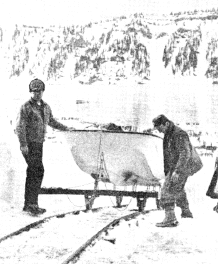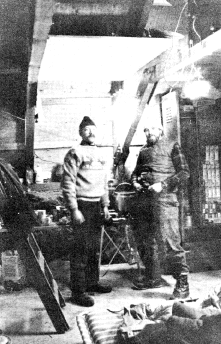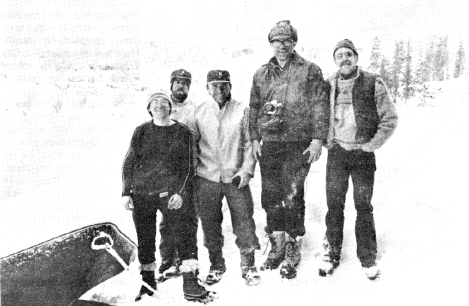Crater Lake Accomplishes First Winter Water Quality Sampling
Park Science, Vol. 7, No. 2
Winter 1987, pp. 3-4
BY Jonathan B. Jarvis
National Park Service
Dept. of Interior
Since the initiation of the Crater Lake NP (CRLA) Limnology program in 1982, the need has existed to monitor the lake water quality in winter. All sampling in the past has been restricted to the approximately 80 days of summer. Data collected only in summer restricts the interpretation of the understanding of overall water quality. Winter logistics are extremely difficult, since the park receives over 500 inches of snowfall each year and the lake lies at the bottom of cliffs ranging in height from 606 to 2000 feet. Once on the lake, the boat used must be capable of extracting samples from the entire 2000 feet of lake depth. Still, winter monitoring was determined to be essential to understanding of the Crater Lake ecosystem, so preparations began in early 1985 for a trip in the winter of 1986.
 |
| Out to launch the research boat, after digging out the ramp from boathouse to water’s edge, are Gary Larson (left) and Jerry McCrea. |
Boathouse is Constructed and Stocked: In the summer of 1985, CRLA staff, a Student Conservation Association High School Work group, the Tokete Hotshot fire crew, and the Medford Reserve Seabees constructed a boathouse an Wizard Island. The boathouse consists of a marine rail system with generator powered winch and cable, attached to dollies that allow the removal and deployment of the parks two primary research vessels. The rear of the boathouse is designed as a separate work/storage/sleeping area of approximately 360 square feet. At the end of the summer, two metal cabinets on the raised floor were stocked with non-perishable food items. Food for four persons for 30 days was estimated and stored. Three 55 gallon drums of gasoline, hand pump, outboard oil and spare parts were stored in the main area of the boathouse. Tools, lumber, nails. insulation, and a variety of other necessary items were left in the boathouse when it was closed in the fall.
Preplanning and Practice: A “Position Statement and Operational Plan for winter and Spring Research on Crater Lake, Crater Lake National Park 1986” was prepared, reviewed and approved. Several methods for access were studied, and it was determined that helicopter transport was the safest. The use of a tree lined corridor and/or avalanche prone snow chute were considered only as an exit route in an emergency. A practice session was carried out with team members plus CRLA ranger staff. They practiced self arresting, ice axe techniques, and teamwork on snow, and spent the night in snow caves within the caldera. Contacts were made with helicopter contractors and with the 304th Air Force Unit. Press interest developed and was accommodated by the park PI0 and the Team Leader. The team expected to set-up a field laboratory in the boathouse. so necessary lab instruments and chemicals were boxed for transport to the island. All equipment was weighed labeled and numbered for slingload transport. An important item in this equipment was a Zodiac inflatable boat with a 25hp engine, to serve as back-up to the researchers and access to the shore if use of the tree corridor was necessary as an emergency exit from the caldera.
In January and February, 1986, two attempts were made to reach the lake. Both were canceled when inclement weather restricted use of the helicopter.
Chronology of Successful Sampling Trip:
March 4: Based on the U.S. Weather Bureau’s predictions helicopter was contracted for transport of the team to the Island.
Team Members:
- Jon Jarvis. CRLA Resource Management Specialist, Team Leader
- Roger Andrascik, CRLA Park Ranger, Alternate Team Leader
- Jerry McCrea, CRLA Biotechnician
- Mark Buktenica, CPSU Biotechnician
- Gary Larson, NPS Aquatic Ecologist and CRLA PI.
The helicopter transported the team and four slingloads of equipment to the island without problem. The remainder of the day was spent shoveling 15 feet of snow away from the front of the boathouse and preparing the boats for deployment.
March 5: The Boston Whaler was deployed in excellent weather and the following tests were completed at Station 13: Physical/Chemical: temperature, chemistry, photometer, secchi. trace metals, color, Biological: phytoplankton, zooplankton. The Zodiac was inflated as a back-up boat and two team members remained in the boathouse to serve as rescue.
March 6; On this day the rain began, with 1.45 inches of precipitation recorded for the 24 hrs. The following samples were taken at Station 13: Biological: chlorophyll and nutrient. Springs also were sampled for nutrients. Numerous avalanches, some of vary large we. were observed within the caldera.
March 7: The rain began to switch to snow with 2.02 inches of precipitation in the 24 hour period A small field laboratory was set up and the chemical (SC, DO, TA, and pH) analysis of samples collected over the previous days was completed A generator operated the instrumentation. Though the field and laboratory work was complete and the team was ready to leave, the weather did not permit the use of a helicopter. Forecast from the U.S. Weather Bureau and the Northwest Avalanche Center did not predict a window for helicopter flight in the next 24 hours.
March 8: Overnight, the temperature fell to 24 F and .79 inches of precipitation fell. The team members continued routine tasks in the boathouse and waited for the window lo return. A plan of escape was developed in anticipation of having to climb out to save the samples before they were spoiled by time. The water samples were divided evenly to equal 28 lbs. per person. Each person emptied his pack to keep weight under 50 lbs. The team would use the tree corridor to climb out, thereby avoiding the use of the avalanche prone chute. The Zodiac would be used to access the shore and it would be cached at the tree corridor for future use. The team went to bad anticipating the climb out.
March 9: Overnight, the temperature fell below 19 F and 31 inches of precipitation fell. A window in the weather finally opened in late morning and the helicopter lifted the team and samples from the island. Samples were then analyzed in the park laboratory and the Forestry Sciences Laboratory at Oregon State University.
Conclusions and Findings: The data collected during the winter trip were not by themselves significant. However, they provided the background for understanding the data collected in the following summer. The nutrient recharging that occurs during the winter sets the stage for the summer’s biological activity Only through comparison to the winter data can we understand the significance of the winter data. It also was noted that avalanches carry large volumes of soil into the lake during the winter and this contributes significantly to the water clarity measurement values. Actual data collected on the trip will be published in the 1986 Crater Lake Limnology Annual Report, available in late winter, 1986. We have shown that Crater Lake can be successfully sampled in winter with proper planning and preparation. Future trips are planned for FY87.
Jarvis was Resource Management Specialist at Crater Lake NP until October 1986, when he became chief of Resource Management at North Cascades NP.
 Crater Lake NP Supt. Bob Benton has announced a new action plan for the park, based on the Director’s 12 point plan. Among recent accomplishments, in addition to development of a complete inventory of historic, current, and future Crater Lake water quality data:Nice place to visit, but you wouldn’t want to live here is the verdict from Jon Jarvis (left) and Roger Andrascik as they look over the team quarters behind the boathouse.
Crater Lake NP Supt. Bob Benton has announced a new action plan for the park, based on the Director’s 12 point plan. Among recent accomplishments, in addition to development of a complete inventory of historic, current, and future Crater Lake water quality data:Nice place to visit, but you wouldn’t want to live here is the verdict from Jon Jarvis (left) and Roger Andrascik as they look over the team quarters behind the boathouse.
– Completion of the Natural and Cultural Resources Management Plan for the park.
– Removal of hazardous and toxic wastes from the park.
– Inclusion of the Bicentennial of the Constitution into Crater Lake interpretive programs.
– Assignment of Interpretive personnel to the lake research vessel. (Interpretive rangers were able to give visitors the latest findings from Lake studies during the 1986 summer season.)
***previous*** — ***next***


